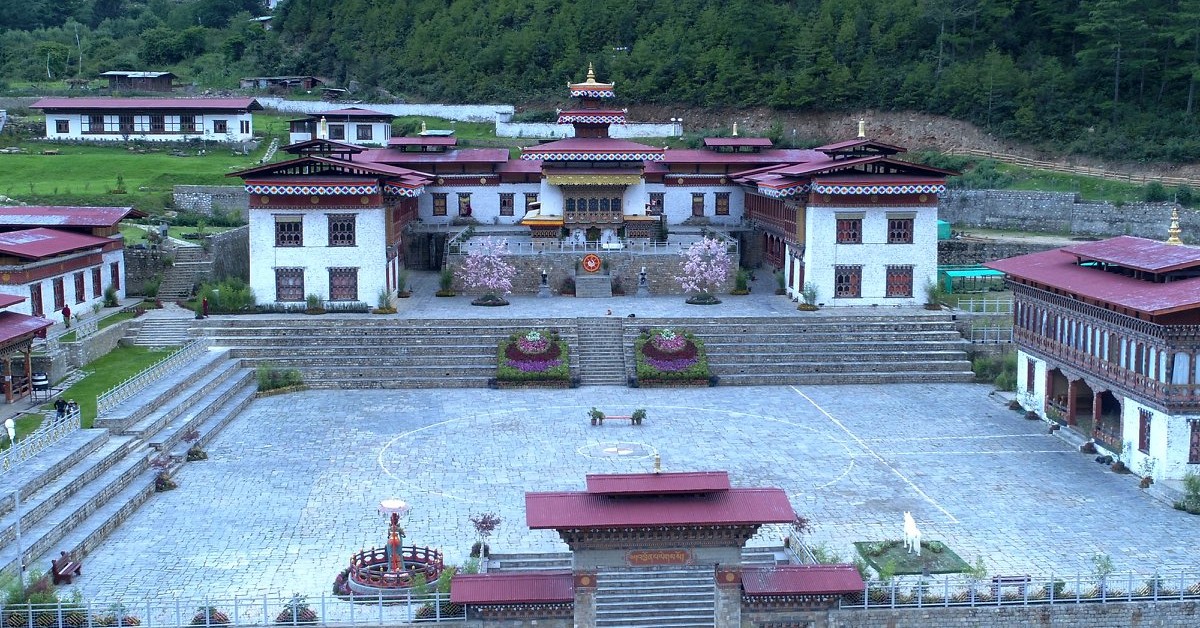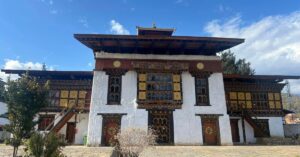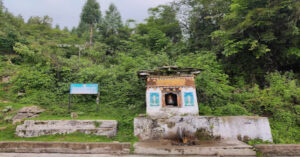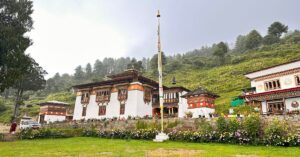Lhakhang Karpo, also known as the “White Temple”, is a one-story temple founded by Songtsen Gampo in 659 CE in the Haa Valley. It was built as part of the 108 temples to subdue a demoness disrupting the spread of Buddhism in the Himalayan region.
With its counterpart, Lhakhang Nagpo (Black Temple), the White Temple is located at the base of the revered Meri Puensum mountains in Dumchoe village of Uesu Gewog, under Haa Dzongkhag, at an elevation of 3,366 meters.
Largest in the Haa, Lhakhang Karpo is regarded as the second abode of Ap Chundu, the first being Gechu Lhakhang. It has housed the monastic body of Haa since 1985, with 180 monks.
The most well-known temples built in Bhutan among the 108 temples in the Himalayan region are Kyichu Lhakhang in Paro and Jambay Lhakhang in Bumthang. The other lesser-known temples believed to have been built by Songtsen Gampo include Khiney Lhakhang in Lhuentse and Konchogsum Lhakhang in Bumthang.
How to Reach Lhakhang Karpo
Lhakhang Karpo is located near the Haa Wangchuk Lo Dzong in Haa Valley. From Paro International Airport, the white temple is approximately 65 km away, a 2-hour drive via the scenic Chele La Pass. From Thimphu, Haa is approximately 110 km away and takes around 3 hours to reach by car. Once in Haa town, Lhakhang Karpo is easily accessible by a short drive or a walk.
Sacred Relics to See at Lhakhang Karpo
- Statue of Amitayus (Tshepakmed);
- Local Guardian Deity Ap Chundu;
- Tashi Gomang Stupa;
- Statues of Zhabdrung Ngawang Namgyal.
Historical Significance of Lhakhang Karpo
Lhakhang Karpo (White Temple) was built by Songtsen Gampo, the Dharma King, in 659 CE.
According to the history of Lhakhang Karpo, the White Temple was founded by Songtsen Gampo, the Tibetan Dharma King, in the 7th century. The temple was built as part of a project to build 108 temples in a single day, aimed at subduing an ogress who opposed the propagation of Buddhism in the Himalayan region.
It is said that Songtsen Gampo released a white pigeon to choose the destined site, and the bird landed at the foothills of the Meri Puensum mountains, marking the location for Lhakhang Karpo. Then the temple was built miraculously as a single-story structure without human labor, with stones arranged haphazardly, reflecting its divine origins. The temple was named Lhakhang Karpo, meaning the White Temple, referring to the white pigeon.
Renovations of the White Temple
The first renovation of the Lhakhang Karpo was undertaken in 1983 to establish the Dzongkhag monastic body of Haa. An extensive renovation project was initiated in 2010, following His Majesty’s command to restore the site in November 2009. During the renovation, the main Lhakhang Karpo temple was restored with its original architectural style. The project also built several monks’ quarters and other amenities to accommodate approximately 180 monks. Lhakhang Karpo Temple was consecrated on the 110th Anniversary of Bhutan’s National Day in 2017. However, it was officially reconsecrated on June 16, 2018.
Description of Lhakhang Karpo Temple
The main relic of Lhakhang Karpo is a statue of Tsepamey, the Buddha of Longevity.
Lhakhang Karpo is located at the foothills of the Rigsum Goempo Mountains. At the entrance, a huge intricately carved gate with two side doors greets visitors to the sacred Lhakhang. When you enter the gate, a Choedpai Lham stands on the left side, while on the right side is a statue of Ap Chundu’s White Horse. The courtyard in front of the Lhakhang is smoothly leveled, serving as a space for rituals, Tshechu performances, and other community events. On either side of the courtyard are the buildings for the kitchen and residences of the district monastic body of Haa.
Walk up straight through the steps to reach the main temple. The wall of the central Lhakhang is painted with Neten Chudru and features a Mani Lhakor. This one-story central Lhakhang is surrounded by two-story buildings built in U or C shape, housing classrooms and monks’ offices.
In the main Lhakhang, four engraved central wooden beams support the ceiling. The main relic is a statue of Sangye Tshepamey, the Buddha of Longevity. It is believed to have been miraculously crafted, as the statue’s head is slightly bent and disproportionately large compared to the body. Legend has it that its head was damaged multiple times during construction until a mysterious man, believed to be a manifestation of the local deity Ap Chundu, provided a suitable replacement.
There are also two altars on the left and right sides of the main altar dedicated to Ap Chungdu.
The walls inside the Lhakhang are decorated with paintings of Chukchi Zhey (Eleven-headed Avalokiteshvara), Dolma (Tara), Dralha Chungdu, Guru Tshengye, Neten Chudruk (the sixteen Arhats), Tshe Lha Namsum (deities of long life), and Tungshagi Lha (Buddhas of confession).
Festival of Lhakhang Karpo
Haa Tshechu is a 3-day annual festival held from the 8th to the 10th day of the ninth month of the Bhutanese Calendar in the courtyard of Lhakhang Karpo temple. The festival features various mask dances, including cultural performances, folk songs, and dances, as well as the unfurling of the Guru Nangsi Zilnon Thongdrol.
Another significant festival is Ap Chundu’s Lhapsoel. It is held annually on 1st November to honor Ap Chundu, a guardian deity of the Haa region. The festival begins at the Lhakhang Karpo at 4:45 am and concludes at the Jyenkakha ground around 2:00 pm.
Best Time to Visit Lhakhang Karpo
Lhakhang Karpo is a year-round destination, but the best time to visit depends on your preferences. The autumn (September-November) season is the best time for attending the Haa Tshechu and Ap Chundu’s Lha soel. You can also go on Haa Panorama Hiking during this season. You can visit the major pilgrimage sites of Haa with the Bhutan Pilgrimage Package.
Conclusion
Lhakhang Karpo, also known as the White Temple, was founded in 659 CE by Songtsen Gampo to subdue a demoness obstructing the spread of Buddhism throughout the Himalayan region. Today, this ancient temple in Haa Valley is home to the Dzongkhag Monastic Body. Its lively festivals, such as the Haa Tshechu and Ap Chundu’s Lha-soel, attract locals and visitors alike.
Places to Explore in Haa
Rangtse Ney: A sacred abode of Guru Rinpoche located in Chego village under Haa Dzongkhag at an altitude of 879 meters above sea level.
Lhakhang Nagpo: Also known as the “Black Temple”, it is a one-story temple founded by Songtsen Gampo in 659 CE in the Haa Valley.
Shelkar Drak Lhakhang: A small temple built on a cliffside in Haa, founded by Choglay Jigme Tenzin, the sixth speech incarnation of Zhabdrung Rinpoche.
Jo Bay Tsho: A hidden lake that stretches approximately 300 by 200 meters in length, nestled along the border of Sombaykha and Gakiling Gewogs in Haa.
Enjoyed reading this blog?




